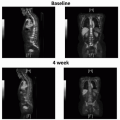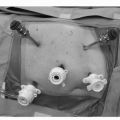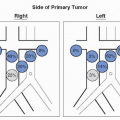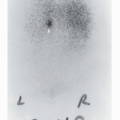Prevention of Prostate Cancer
Barbara Ercole
Javier Hernandez
Ian M. Thompson Jr.
INTRODUCTION
Major advances have been made in the diagnosis and treatment of prostate cancer. However, prostate cancer remains a significant health-related problem in our population. Prostate cancer is the most common cancer and the second most common cause of cancer death in men and is therefore a significant public health concern in the United States. Prior to the introduction of widespread prostate-specific antigen (PSA) screening for prostate cancer, the disease presented mostly at advanced stages. After the advent of PSA testing in the 1980s, prostate cancer incidence rose sharply, but since the 1990s, the incidence has been declining as has prostate cancer mortality (1). Death rates for prostate cancer have decreased by 4.1% per year during 1994 to 2005 as reported by Jemal et al. (2). Approximately 91% of prostate cancers diagnosed between 1996 and 2004 were identified while the disease was confined to the prostate, in contrast to a 25% rate of organ-confined disease prior to the introduction of PSA screening (2,3,4). Concurrent with the substantial national focus on early detection of prostate cancer, 5-year cancer-specific survival rates have increased from approximately 70% in the early 1980s to close to 100% in the early 2000s (2,5).
The reason for this decline in mortality in prostate cancer is not completely clear. Possible explanations include widespread PSA screening with application of curative treatment, changes in dietary habits (e.g., reduction in dietary fat or increased use of micronutrients), early use of hormonal treatment, increased use of statins for hyperlipidemia, improved treatments including the use of adjuvant therapies (e.g., adjuvant radiation), or even chemoprevention of prostate cancer by certain agents. The notion that PSA screening may have had an impact on decreased mortality rates is attractive when evaluating outcomes from radical prostatectomy series (6,7). PSA screening, however, has many limitations. Concerns about the detection of clinically insignificant disease and the economic implications of widespread screening are only some of the controversial aspects of PSA screening (8,9,10,11). Two large-scale studies have addressed the impact of screening on population mortality and have resulted in opposing findings. The Prostate, Lung, Colon, Ovarian, Cancer Screening Project trial in the United States randomized men to a fixed period of repetitive PSA screening visits versus general community practice; the European Study of Screening for Prostate Cancer (ERSPC) was a similar trial that examined screening in Europe (12,13). The two trials came to different conclusions regarding prostate cancer mortality: the US trial found no reduction in prostate cancer mortality, while the ERSPC study found a 20% prostate cancer-specific mortality reduction with screening. Both studies had serious limitations. The US trial had significant rates of screening in the control arm and had a relatively low rate of biopsy in those men with abnormal screening results. Follow-up as well was relatively short, given the prolonged natural history of the disease. The ERSPC trial has also been criticized by its patchwork nature of study designs as well as the interpretation that the mortality reduction was achieved as a result of an investment in tremendous amount of resources and time: to prevent one prostate cancer death, over 1,400 men required screening over almost a decade, and almost 50 men required treatment. Both studies demonstrated very clearly two observations: (a) screening for prostate cancer requires a substantial investment including the very real potential for significant overtreatment for many prostate cancers and (b) if the public health goal is to prevent death and suffering from prostate cancer, screening alone is inadequate. The stage migration caused by PSA detection has resulted in large numbers of men treated for cure but with modalities that some have argued are more expensive than treatment of late-stage disease (10). An estimated $8 billion is spent on prostate cancer treatment each year in the United States (14). A study from US military medical centers demonstrated significant costs associated with the treatment of prostate cancer in the last year of life of patients dying from this malignancy (15). Other investigators have estimated the expense and associated survival benefit of treating critically ill cancer patients, demonstrating that limited benefits are usually obtained at a high cost (16). It is against this backdrop that strategies designed to prevent prostate cancer may prove beneficial not just in reducing the burden of disease for the individual but also in reducing the cost burden for society.
RATIONALE FOR PREVENTION
Prevention strategies for prostate cancer may have two pragmatic goals. One such goal would be prevention of disease over the lifetime in a man who would otherwise manifest the disease. Another somewhat different approach would be to modulate the risk of progression of premalignant lesions or clinically insignificant cancer into clinically significant disease. Such an approach might be thought of as reduction in risk of progression, rather than prevention. In either case, the ultimate outcome would be beneficial—an individual man would not face the diagnosis of prostate cancer during his lifetime. It must be understood that prevention is quite different from treatment: a patient undergoing treatment may be more willing to accept side effects and costs of treatment versus someone who is seeking risk reduction measures. Due to these differences, a preventive intervention must have minimal toxicity, be inexpensive, and must have a reasonably good ability to reduce the risk of cancer. Ideally, the preventive intervention ought to have other salutary outcomes.
Experience with preventive strategies in other malignancies and disease processes have proved to be successful. One such example is the use of aspirin as secondary prevention of cardiovascular disease (17). With regard to cancer, a number of malignancies have been linked with environmental factors such as diet and tobacco use, among others. Efforts to increase awareness and reduce risk among the population are underway (18). Chemoprevention has been proved effective in a number of neoplasms as well, including breast and colorectal disease.
Tamoxifen and raloxifene are known to reduce the incidence of estrogen-receptor-positive breast cancer in women (19).
Tamoxifen and raloxifene are known to reduce the incidence of estrogen-receptor-positive breast cancer in women (19).
Preventive strategies could potentially have major economic implications, recognizing that the costs associated with the actual preventive efforts would have to be taken into consideration as well. The impact of prevention of prostate cancer on quality-of-life-related issues must be considered, just as cost is a major consideration with screening and treatment practices (20). One clear-cut advantage of a prevention strategy, compared with treatment for cure, is the lack of treatment-related morbidity such as postprostatectomy incontinence or radiation cystitis.
HORMONAL MANIPULATION
Hormonal manipulation via androgen and nonandrogen pathways has been tested for the prevention of prostate cancer in phase III trials. Selective estrogen receptor modulators, such as toremifene, may have potential in preventing the pathogenesis of prostate cancer. Its potential was demonstrated in a mouse model via nonandrogen pathways where 60% of toremifenetreated animals were tumor free (21). Toremifene was also tested in a phase IIb trial for prevention of high-grade prostate intraepithelial neoplasia (HGPIN) in men (22). This was a randomized double-blind, dose-finding, placebo-controlled, parallel group clinical study of 514 patients with HGPIN. Men were randomized to 20, 40, or 60 mg of toremifene versus placebo daily for 12 months. Biopsies were repeated at 6 and 12 months. Study outcomes found that the 20 mg dose was the most effective. Prostate cancer was diagnosed in 31.2% of men in the placebo group compared to 24.4% of men treated with 20 mg of toremifene (p < 0.05). The authors concluded that 20 mg of toremifene decreased the cumulative risk of prostate cancer at 1 year by 21.8% when compared to placebo. The annualized rate of prevention was 6.8 cancers per 100 men treated. Side effects were similar among the toremifene and placebo groups. To further define the chemopreventive effects of toremifene, the 20 mg dose is being evaluated in a large, multicenter, phase III pivotal clinical study (22).
There is strong evidence indicating an association between androgens and the risk of prostate cancer. Testosterone, much of which originates from the Leydig cells, is converted to dihydrotestosterone (DHT) within prostate cells by 5α-reductase type I and II enzymes. Type I 5α-reductase is the predominant isoform in prostate cancer tissue and to a lesser extent in benign prostatic hyperplasia tissue (BPH), while type II is present in normal prostatic tissue and BPH (23,24). DHT, with much greater affinity for the androgen receptor (AR) than testosterone, plays a crucial role in the development of the prostate gland. Individuals affected by hereditary 5α-reductase deficiency fail to have adequate levels of DHT to allow proper development of the prostate and external genitalia and present with varying degrees of ambiguous external genitalia (25). These individuals have a rudimentary prostate, undetectable serum PSA levels as adults, no evidence of prostatic epithelium on prostate biopsy, and fail to develop BPH or prostate cancer (26). Conversely, some investigators have also suggested that higher levels of testosterone may pose a higher risk of prostate cancer, although these observations have not been uniform (27,28). Observations across different ethnic groups also support a role of androgens in the risk for prostate cancer. Androgen levels have been reported to be higher in African American and non-Hispanic white men than in lower risk populations such as Japanese men (29). Additionally, Japanese men have lower levels of 5α-reductase activity compared to their higher risk counterparts.
Advances in molecular biology have facilitated identification of various genetic polymorphisms associated with an increased risk for prostate cancer. Many of these genes are directly related to androgen activity. The gene that has been the focus of the most intense molecular studies is the AR, which binds both testosterone and DHT and transactivates the gene with androgen response elements (30,31,32). Additional studies have evaluated the role of other genes involved with androgen metabolism (SRD5A2, CYP17, and CYP3A4) and the risk of prostate cancer (33,34,35). Evidence from these studies indicates that genetic alterations directly related to androgen metabolism may have an impact on the risk of prostate cancer and provides a further rationale for hormonal manipulation as a chemopreventive strategy for prostate cancer. A myriad of methods to modulate the androgenic milieu are options for prostate cancer prevention. Among these are antigonadotropins (synthetic estrogens, LHRH agonists, and antagonists), nonsteroidal antiandrogens, steroidal antiandrogens, adrenal androgen inhibitors, steroidal 5α-reductase inhibitors, as well as natural antiandrogens and antiestrogens (36). Because any chemoprevention strategy recommended for otherwise healthy men must place as its paramount goal a virtually nil risk of side effects, many of these agents would be unacceptable for widespread use for chemoprevention due to their unacceptably high risk of toxicity.
Finasteride is a competitive inhibitor of type II 5α-reductase that blocks the conversion of testosterone to DHT within prostatic cells (37). Extensive evidence from clinical trials has demonstrated a role for 5α-reductase inhibitors in the treatment of BPH and prevention of BPH-related outcomes. The Proscar Long-Term Efficacy and Safety Study (PLESS) indicated that finasteride reduces the risk of acute urinary retention and the need for BPH-related surgery by approximately 50% (38). A large-scale clinical trial evaluating the role of combination therapy for BPH confirmed a role for finasteride in the prevention of clinical progression of BPH (39). These observations along with the ones previously discussed raised the possibility that 5α-reductase inhibitors might be effective chemopreventive agents against prostate cancer. Preclinical data also suggested a chemopreventive role for finasteride against prostate cancer. Tsukamoto conducted a study in F344 rats to evaluate the effect of finasteride on rat prostate carcinogenesis. In this study, finasteride prevented the progression of microscopic prostate carcinoma to macroscopic disease (40). Other clinical observations further support the notion that finasteride might be effective in the prevention of prostate cancer. Men randomized to take finasteride in the PLESS were less likely to be diagnosed with prostate cancer compared to the placebo group (41). These results did not achieve statistical significance (p = 0.7) but a relatively small number of patients (n = 644) underwent prostate biopsy. Another study suggested that finasteride can delay the progression of prostate cancer in men with a detectable PSA after radical prostatectomy with no clinical or radiographic evidence of metastasis (42).
The Southwest Oncology Group (SWOG) supported by the National Cancer Institute (NCI) released the results of the Prostate Cancer Prevention Trial (PCPT) in 2003 under recommendations from the Data Safety and Monitoring Committee (11). PCPT was the first phase III trial conducted for the prevention of prostate cancer. In this study, 18,882 men 55 years or older who had a normal digital rectal examination (DRE) and a PSA level equal to or >3.0 ng/mL were randomized to receive 5 mg of finasteride daily versus placebo after a placebo run-in period of 3 months. Participants were to remain on the study drug for 7 years; at the time of publication, 19% of study participants had not yet reached their 7-year time point. A prostate biopsy was recommended if, during one of the annual visits, participants were found to have a PSA level <4.0 ng/mL or had an abnormal DRE; in the finasteride group, the PSA was adjusted to ensure a similar rate of biopsy recommendations. A prostate biopsy was recommended at the end of the 7-year study period for all participants who had not been previously found to have
prostate cancer. This study found a 24.8% (p < 0.001) relative risk reduction in the prevalence of prostate cancer over the 7-year period in men who received finasteride. This risk reduction was seen across all risk groups (age, ethnicity, PSA, family history). Of concern was the observation of a higher proportion of high-grade tumors (Gleason score 7 or higher) in the finasteride group. Additionally, men on the finasteride arm of the study were more likely to report sexual side effects, though this was subsequently found to be minimal from a clinical standpoint (43). The risk of lower urinary tract symptoms and the need for interventions, such as transurethral resection of the prostate, was lower in the finasteride group. The latter findings were consistent with those of the PLESS and Medical Therapy of Prostatic Symptoms (MTOPS) trials.
prostate cancer. This study found a 24.8% (p < 0.001) relative risk reduction in the prevalence of prostate cancer over the 7-year period in men who received finasteride. This risk reduction was seen across all risk groups (age, ethnicity, PSA, family history). Of concern was the observation of a higher proportion of high-grade tumors (Gleason score 7 or higher) in the finasteride group. Additionally, men on the finasteride arm of the study were more likely to report sexual side effects, though this was subsequently found to be minimal from a clinical standpoint (43). The risk of lower urinary tract symptoms and the need for interventions, such as transurethral resection of the prostate, was lower in the finasteride group. The latter findings were consistent with those of the PLESS and Medical Therapy of Prostatic Symptoms (MTOPS) trials.
An initial editorial cautioned against widespread use of finasteride for the prevention of prostate cancer due to the increase in high-grade prostate cancer in the finasteride arm (44,45). Subsequent publications by the investigators examined the effects of finasteride in the trial and helped clarify these findings. Regarding PSA, it was found that finasteride significantly enhanced the ability of PSA to detect prostate cancer and high-grade prostate cancer, increasing sensitivity and specificity of this biomarker when compared to PSA’s performance in the placebo group. The area under the receiver operator curve (AUC) for PSA was increased significantly from the placebo to finasteride group in the study. For overall detection of prostate cancer, the AUC was increased from 0.681 to 0.757 (p < 0.001); for Gleason 7-10 disease, it was increased from 0.781 to 0.838 (p = 0.003); for Gleason 8-10 disease, it was increased from 0.824 to 0.886 (p = 0.071) (46). When examining effects of finasteride on DRE, the results demonstrated an increase in sensitivity of DRE in detecting prostate cancer (16.7%-21.3%; p = 0.015) with no reduction in specificity. There was also an increase in the sensitivity of DRE for detection of high-grade cancers, although this did not reach statistical significance (47). When examining the impact of finasteride on the risk of development of high-grade prostatic intraepithelial neoplasia, a putative premalignant histologic entity, a reduction from 11.7% to 9.2% (p < 0.001) was noted (48). The investigators also addressed whether the increased risk of high-grade cancers was due to a suspected pathological artifact. Independent pathological review found no statistically significant differences in histologic changes consistent with a “hormonal effect” between biopsies in the two study groups (49). A major other impact of finasteride appears to be improved biopsy detection of high-grade prostate cancer. Comparing biopsy grade with radical prostatectomy grade in patients in the two study arms who ultimately underwent surgery, it was observed that in the placebo group, about 50% of men who were ultimately found to have high-grade prostate cancer (Gleason 7-10) in the radical prostatectomy specimen had low-grade cancer (Gleason ≤6) found at the time of biopsy. This rate of undergrading was reduced to about 30% in the finasteride group. While this phenomenon cannot be completely understood with available data, a reasonable explanation is the 25% reduction in gland volume with finasteride leading to more accurate sampling of the prostate with prostate biopsy.
To understand what the true impact of finasteride administration was in the PCPT, given the multiple manners in which finasteride enhanced cancer detection as well as enhanced detection of high-grade cancer, several authors have used methods to combine these data. The primary PCPT team, led by Redman, performed one of these comprehensive analyses (50). Through examination of the biopsies only, the bias adjusted rates of prostate cancer in the two groups were 21.1% (4.2% high grade) in the placebo group versus 14.7% (4.8% high grade) in the finasteride group. A 30% risk reduction in prostate cancer (p < 0.0001) and a nonsignificant 14% increase in high-grade cancer (p = 0.12) with finasteride were noted. When all biases were included, the authors found that the overall cancer risk reduction was 30%; the reduction in risk of low-grade disease was 32%, and the impact of finasteride on high-grade disease was a risk reduction of 28%. Three other independent analysis using different methodologies reviewed the PCPT data and also concluded that detection and sampling biases with finasteride likely explained the increased risk of high-grade disease (51,52,53).
Another 5α-reductase inhibitor under study is dutasteride. Dutasteride is a type I and type II 5α-reductase inhibitor leading to >90% reduction in serum DHT (54,55). The design of the REDUCE (Reduction by Dutasteride of Prostate Cancer Events) trial to test the potential of dutasteride as a chemopreventive agent (56) is based on the results of PCPT as well as preliminary results with dutasteride. Andriole et al. demonstrated, in a randomized trial of dutasteride for BPH (n = 4,325), an approximate 50% reduction in prostate cancer in the dutasteride group at 27 months (2.5%-1.2%; p = 0.002) (57). The REDUCE trial was subsequently designed and powered to further test these findings (56). A total of 8,000 men will be randomized to receive either 0.5 mg of dutasteride or placebo for 4 years. Eligible men must have a negative biopsy at study entry. PSA for eligible men between ages 50 and 60 must be between 2.5 and 10 ng/mL, and for ages 60 to 75 must be between 3 and 10 ng/mL. Biopsies will be obtained at 2 and 4 years. Although this study has not been published at the time of this paper, it was presented at the 2009 American Urological Association annual meeting with a 22.5% reduction in risk of cancer at the 2-year biopsy point and a 23.5% reduction in risk at the 4-year mark.
It would then appear that 5α-reductase inhibitors, as a class, reduce the risk of prostate cancer in both the general population (that of the PCPT with a PSA <3.0 ng/mL) as well as the population of men with a higher level of PSA and in whom a biopsy has demonstrated no cancer but in whom repeated biopsies over ensuing years may subsequently find cancer. The approximate 25% reduction in risk of prostate cancer of these agents represents a large public health benefit. The 50,000 men in the United States alone who would not face the diagnosis of prostate cancer on an annual basis represent a major impact, both from an economic as well as personal standpoint. The data regarding PSA performance also suggest that the administration of these agents may improve the ability of prostate biopsy to detect high-grade cancer at an earlier point, especially with the increased interest in active surveillance for patients with lower grade disease. Certainly, active surveillance for a man with Gleason 3 + 3 disease whose prostate actually harbors higher-grade disease is a poor option; the risk of this outcome would appear to be reduced with finasteride. The additional benefit in symptoms related to BPH (fewer transurethral resections of the prostate [TURP], fewer cases of urinary retention, improved symptoms) must also be considered, especially given the confirmation and extension of these observations in the MTOPS trial. This double-blind clinical trial demonstrated that finasteride led to a 34% risk reduction of overall clinical progression of BPH compared to placebo. When used in combination with doxazosin, the overall risk reduction increased to 66% compared to placebo (39). On the other hand, a man choosing chemoprevention should also be warned of the potential side effects such as a reduction in ejaculate volume, risk of gynecomastia, and cost of the drug. Prevention with finasteride is probably best applied to the man who has opted for PSA screening and DRE testing as this is the population of men in which chemoprevention has been proven effective in the PCPT. At this time, two warnings must also be issued in regard to screening: (a) the impact of screening on mortality is relatively low and (b) should cancer be detected, there is often a significant reduction in quality
of life with definitive treatment (sexual, gastrointestinal, urinary) or active surveillance (anxiety). Ultimately, it will be the balance of the reduction in prostate cancer risk against the potential side effects that will lead to an informed decision by the patient.
of life with definitive treatment (sexual, gastrointestinal, urinary) or active surveillance (anxiety). Ultimately, it will be the balance of the reduction in prostate cancer risk against the potential side effects that will lead to an informed decision by the patient.
CYCLOOXYGENASE-2 INHIBITORS AND NONSTEROIDAL ANTI-INFLAMMATORY DRUGS
Cyclooxygenases (COX-1 and COX-2) are involved in the conversion of arachidonic acid to prostaglandins and other eicosanoids. COX-1 is expressed in almost all tissues throughout the body to include platelets, endothelial cells, gastrointestinal tract, and renal microvasculature. COX-2, on the other hand, is usually undetectable in most tissues except in response to injury or hypoxia when its expression is stimulated by inflammatory cytokines, growth factors, or endotoxins. Prostaglandins and eicosanoids exert their activity by influencing tumor cell proliferation, resistance to apoptosis, enhanced hormonal responsiveness, angiogenesis, and tumor invasion (58).
Stay updated, free articles. Join our Telegram channel

Full access? Get Clinical Tree








